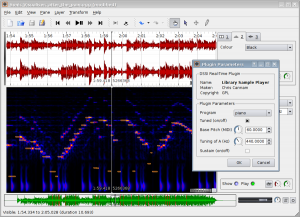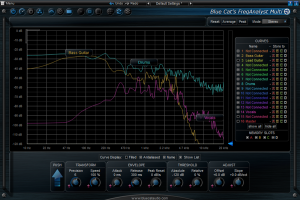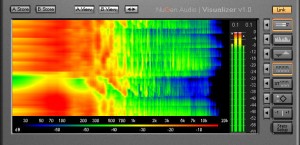Plugin Roundup: Frequency Analyzers and Metering Tools
There’s no substitute for mixing with your ears. Too much visual stimulation can be a hindrance where audio craftsmanship is concerned, and because of this, one of my favorite plugins to date is a promotional freebie from Massey, called “Listen.”
When engaged, the Listen plugin will hide your entire workspace, making your screen glow a gentle solid blue, with one directive written out for you to consider: “Listen.” It’s great advice, and in general, it leads to better mixes.
With that said, sometimes our ears deceive us. Our brains become clogged by superstition, placebo and confirmation bias and we think we hear things that aren’t there.
Compared to other most mammals, our hearing is weak and even at our best, the most ‘golden-eared’ listeners have minds that are far more powerful than their ears. This is why we can turn an EQ knob and think we hear it working, before we realize that it’s not engaged, or that we’ve grabbed the wrong channel. And this is also why the power of the myths and stories that surround an artist often grab new listeners long before their music does.
The Value of Measurement
No good sound mix will ever be completed by relying on ones’ eyes alone. But because of the relative weakness of our ears when compared to the power of our minds, audio measurement tools will always be useful at times.

The free Sonic Visualiser allows you to see your audio without ever even firing up a DAW.
At its best, good measurement can help us come to a greater understanding of reality. It can keep us from engaging senseless, ego-based screeds over matters of taste and assumption. It allows us to set meaningless arguments of minutia to rest, and instead focus on the things that really matter. Needless to say, those are rarely found within any audio circuit.
I had a friendly debate with a colleague just the other day about whether EQs tend to have a more dramatic effect when they’re placed before or after a compressor. Although we disagreed, frequency analyzers make resolving questions like these easy, and they help keep debates civil and grounded in truth over rhetoric. We can quickly try things for ourselves, make repeatable measurements and share our results.
There are practical applications within mixes as well. I rarely pull out a frequency analyzer on more than one out of every 10 or 15 songs, but when I do, they can be enlightening.
A good analyzer is a little bit like a calculator. In the interest of exercise, I’d rather not rely on one too much, but they do help make awkward problems easy, and in extreme cases, make the impossible graspable.
If a mix is sounding a little boxy in the midrange and I’m having trouble deciding exactly where, an analyzer can point me in the right direction. If I’m having trouble getting great results out of a deesser on a particularly tricky vocal passage, I can figure out what exact areas are causing me grief. If I’m trying to match a punched-in tone and have only managed to get 95% of the way there with my naked ears, a frequency analyzer can help save time. And perhaps where they can be of the most help is in sorting out the low-end.
In our recent interview with producer Bob Power for the Input\Output Podcast, Power reiterated the importance of carving out different homes in the low end for competing bass instruments. A bass guitar might occupy the deep registers, while the bulk of a kick drum lives in the upper bass range – or vice-versa.
At Bob Power’s stage in the game, this may be done by ear more often than not. But for beginners, or those who struggle with this balance, analyzers can be a godsend. They can also be fantastic teaching tool – in any register.
Nothing is a substitute for hands on practice and deep critical listening. But sometimes, the right tools can help us speed up our understanding, crystallize new concepts, or overcome stumbling blocks and plateaus.
So without further ado, here are some tools worth exploring.
Blue Cat FreqAnalyst
Blue Cat’s FreqAnalyst made an appearance last week in our “Big List of Free Pro Tools Plugins” as part of the Blue Cat “Free Pack.”
It’s available for both Mac and PC in a complete range of formats, including AAX, RTAS, VST and AU. You can even customize the skins and the display options. And did we mention it’s free?
If you’re just getting started with analyzers, our list could pretty much end here. This plugin does most of what you’ll ever need a frequency analyzer to do.
But if you’re interested in something more, Blue Cat also offers a whole “Analysis Pack” that includes a “Pro” version of this tool along with a stereoscope, oscilloscope, and precision peak meter.
Most powerful of all, perhaps, is the included FreqAnalystMulti, which is a multi-track version of the FreqAnalystPro. This is a tool that will allow you to put one instance on a kick drum, one instance on a bass, and see where their frequency spectrums conflict in the same readout.
This kind of functionality is a real leap forward when it comes to practical in-the-mix analysis. Use it on three competing guitar tracks and see their relationships together all on the same screen. It doesn’t beat using your ears, but it can be a fun supplement, or a unique learning tool.
These advanced tools range from $50 to $100 and can be purchased together in a bundle for $189.
Vintage-Style LED Analyzers
The one issue that comes to mind with Blue Cat’s tools is that they can be too advanced. For those who prefer a more minimalist readout, there are other options.
ReFuse Software makes a 30-band Real Time Analyzer inspired by the early LED analyzers that divided the frequency spectrum into 1/3 octave bands. The layout is minimal, easy to read, and packs a wallop of 80s nostalgia. It’s also free for users of the VST Pluggo architecture.
There are a couple of similar options for those who don’t use Pluggo:
Vertex DSP makes a free VST and AU tool called the Multi-Inspector which has a 31-band LED-style readout and multi-track functionality.
Meanwhile, Seven Phases makes a VST-only Spectrum Analyzer that is a lot like reFuse’s, only far more customizable, and RML Labs makes an add on Frequency Analyzer for their proprietary SAW Studio program that divides the spectrum into 50 bands.
So far I have not seen a similar tool compatible with Pro Tools. If you come across one, please let us know.
Sophisticated VST and AU only Analyzers
Other developers offer plugins that are on-par with Blue Cat’s once you get outside of Pro Tools’ RTAS and AAX environments and into the wide open waters of VST and AU.
Voxengo’s SPAN is free, and easily one of the most popular, but it’s not the only game in town.
schwa schOPE, by Stillwell Audio, costs $25 and does a lot. According to their website, schwa schOPE is a “multitool, multiview, multichannel waveform, frequency, and stereo phase analyzer that lets you superimpose and view multiple audio signals from every dimension.”
They recommend that you “scope pre- and post-compression signals together to see if you’re flattening peaks. Scope kick drum and bass together for EQ scooping. Scope DI and amped guitar signals together to fix phase problems.”
Nugen Audio’s $89 Visualizer is extremely sophisticated and worth a look as well. It includes precision level meters, spectrum analyzer, a vectorscope, phase correlation meter, stereoscope and more.
Melda Productions’ VST-only Manalyzer offers pre-filtering modes and magnitude normalization for easier screen-reading, along with a useful “Deharmonization” function which “reduces harmonics leaving only fundamentals, which is great for identifying relevant frequencies.” It’s also one of nearly two dozen free VST plugins that the company offers.
Speaking of free, Signal Analyzer by Robin Schmidt is another small one, as is Freakoscope by Mdsp @ Smartelectronix. Both are VST-only, and although the latter offers a neat note-readout feature, and both Fourier and LED-style display options, it is sadly, Windows-only.
Standalone Options
You can also examine frequency and a host of other parameters across several stereo audio tracks at once without ever even firing up a DAW. Sonic Visualiser is 100% free software available under the GNU General Public License.
For those learning about the science of sound, or for long-time engineers looking to increase the depth of their familiarity with the physics that underlies their craft, this, or any of the tools on this list, can be invaluable in moderation.
Please note: When you buy products through links on this page, we may earn an affiliate commission.










Greg Thomas
September 6, 2012 at 6:26 pm (13 years ago)This is a good collection–I’ll have to check these out. Are there any combination EQ/analyzer plug-ins that you recommend? I use Digital Performer, and I really like using the MasterWorks EQ to analyze frequencies and make EQ changes in the same interface. (You can very quickly and precisely find, attenuate, or accentuate frequencies, and then see the effect of your changes without having to negotiate two distinct windows.) Logic has some similar EQ capabilities. But I don’t yet have anything like that for Pro Tools. I wonder if there are any third-party plug-ins that are worth the money to get those functions.
TrustMeI'mAScientist
September 6, 2012 at 7:23 pm (13 years ago)Hi Greg,
I didn’t come across anything like that for Pro Tools myself. Sounds like there’s room for it on the market though! If you do hear of something, please feel free to chime in here.
Jesse
September 6, 2012 at 8:13 pm (13 years ago)I think the izotope plugins have that feature
TrustMeI'mAScientist
September 8, 2012 at 7:13 pm (13 years ago)That is a good addition Jesse. Since that frequency analyzer is part of a full suite of tools in Ozone — rather than a frequency plugin that stands alone — I didn’t end up considering it for this piece.
AudiofileEngineering
September 14, 2012 at 8:20 pm (13 years ago)Hi Justin –
We’d love to get you a copy of Spectre ( http://aeng.me/spectre ) to check out. What’s the best way to get in touch?
Regards,
Dan Comerchero
dan[at]audiofile-engineering.com
TrustMeI'mAScientist
September 17, 2012 at 3:35 pm (13 years ago)HI Dan, I’d be happy to check this out! I’ll send you an email now.
Specan32
September 29, 2013 at 7:05 am (12 years ago)Free Spectrum Analyzer from Russian vendor
http://specana.blogspot.com
Indra
August 12, 2015 at 6:35 pm (10 years ago)does anyone know leq(m) meter other than WLM and Vmeters ? I can’t find any.
Daniel Statnekov
April 8, 2017 at 4:02 pm (8 years ago)I apologize for being such a rank amateur but I would very much appreciate if you can help me with something. If you saw a representation of what looks like a narrow, five tiered step-pyramid on a sound-spectrum analyzer (like gstring, for example), can you please tell me what you would be viewing as far as the sound being expressed is concerned? Here’s a drawing of the graphic representation that I am asking about. Thanks and best wishes, Daniel Statnekov https://uploads.disquscdn.com/images/0147cac555d4f2256b6b85defc735fbd5ccbdb7b0766f470625d2ed4b91ce719.jpg